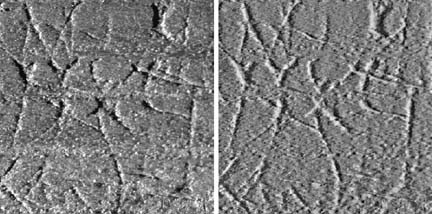
Image Enhancement of Incised Tablets
Imaging Documents: A Symposium
WWW Site
IG, XII 6, 2 (Chios)
Macquarie Centre for Ancient Documentary Studies
P.Macquarie inv. 586(1) and the Sibylline Tradition
Alongside continuing progress on the Centre's project to create an archive of digitised images of its squeeze collection, work has begun on a pilot project, funded by a grant from the Leverhulme Trust and jointly sponsored by the Centre and Oxford University's Department of Engineering Science, to investigate image acquisition and processing techniques to assist in the decipherment of incised texts such as lead tablets and wooden stilus tablets. Veit Schenk, the newly appointed Research Associate for the project, reports below on some promising initial results:
The problem with just taking a digitised image of a stilus tablet is that without carefully choosing the lighting conditions one will see nothing but the largest scratches or marks in the wood. This is due to the fact that the marks left on the surface were left there rather 'unintentionally' when the writer pressed down too hard with the stilus and thus went through the layer of wax into the wood. One method for making these faint marks visible to the eye (or the camera) is to cast shadows by shining light onto the surface at very low angles. In the images taken with a high-resolution camera the scratches then show up as distinct black-white transitions marking the shadow-highlight combination typical for a scratch illuminated from a low angle. But, only scratches/marks more or less perpendicular to the direction of the light source cast shadows-the ones in the same direction as the incoming light are virtually invisible. The obvious solution to the problem is to move the light source around the stilus tablet, to store the scratches detected in each individual view in computer memory and later 'integrate' partial marks into complete 'strokes'.
One of the main problems with this 'multiple-view' approach is the woodgrain which stands out in the images and thus distracts both human viewer as well as the computer algorithm looking for the grooves. So far we have developed a method for removing most of this woodgrain from the images.
The underlying principle of this method, which is based on the fact that the woodgrain is more or less uni-directional, is to remove from the frequency spectrum of the image, i.e. its Fourier-transform, those frequencies that are most likely to contribute to the 'woodgrain' and then transform back to an image using the inverse Fourier transform.

Detailed image of wooden stilus tablet (scanned at 1200 dpi using the Centre's Leaf Lumina camera) before and after Fourier transform, showing removal of woodgrain pattern
Once the woodgrain has been removed from the images the next task is to detect those areas in the image that correspond to the shadows cast by the scratches. Currently we are using a combination of techniques, including histogram equalisation which emphasises the extreme ends of the colour-range, i.e. the black and the white corresponding to shadow and highlight; a 'phase congruency' method which finds areas of high contrast, i.e. the transitions from shadow to highlight; and a so-called 'valley-detector' which utilises the knowledge of where the light-source for a particular image was placed and thus where in the image the highlight can be expected relative to the shadow.
Due to the wide range in the condition and appearance of the tablets neither of the methods mentioned above is fully automated yet, but with a reasonable amount of user-interaction all marks visible to the eye are detected by the computer. Unfortunately, along with the signal of interest the computer also detects 'noise' which corresponds to unrelated scratches in the surface, specular reflections etc. Our work in the next couple of months will therefore concentrate on:
(a) reducing the amount of user-interaction necessary to detect the scratches, (b) implementing measures for distinguishing noise from signal, and - most importantly - (c) integrating individual marks visible in different views into complete strokes or letters.
The next step will then be to compare what we consider 'strokes' on the surface to models of complete Roman letters. This should prove particularly useful when there are multiple texts on one tablet.
We hope to be able to present corresponding results for a range of stilus tablets later in the year.
During the autumn, Dr. Bowman spent a month in Australia at the invitation of the Centre for Ancient Documentary Studies at Macquarie University. He gave lectures on the Vindolanda writing-tablets both at Macquarie and at Sydney University and the University of Queensland, as well as seminars at Macquarie and Sydney Universities on the imaging projects currently being undertaken at CSAD. The Macquarie Centre is developing its own programme for imaging its collection of Greek papyri. It is hoped that this contact will lead to a closer relationship between the two Centres, regular exchange of information and further reciprocal visits for research purposes.
Two of the research staff at Macquarie, Dr. Stuart Pickering and Dr. Rosalinde Kearsley made brief visits to Oxford in April, 1997. During his visit, Dr. Pickering presented a seminar on an important new papyrus fragment in the Macquarie collection. A brief summary follows:
New light is thrown on P.Oslo II 14 (a text apparently belonging to the Sybilline oracle tradition) by an unpublished fragment in the papyrus collection of Macquarie University in Sydney, Australia. P. Macquarie inv. 586(1), from Ptolemaic cartonnage and dating probably to the second century B.C., corresponds to the first seven lines of the Oslo papyrus (which dates to the second century AD), taking the evidence for the transmission of the work back several centuries. In the course of his presentation Dr. Pickering discussed questions of decipherment and identification, and the implications of the new piece for reconstructing the Sybilline tradition.